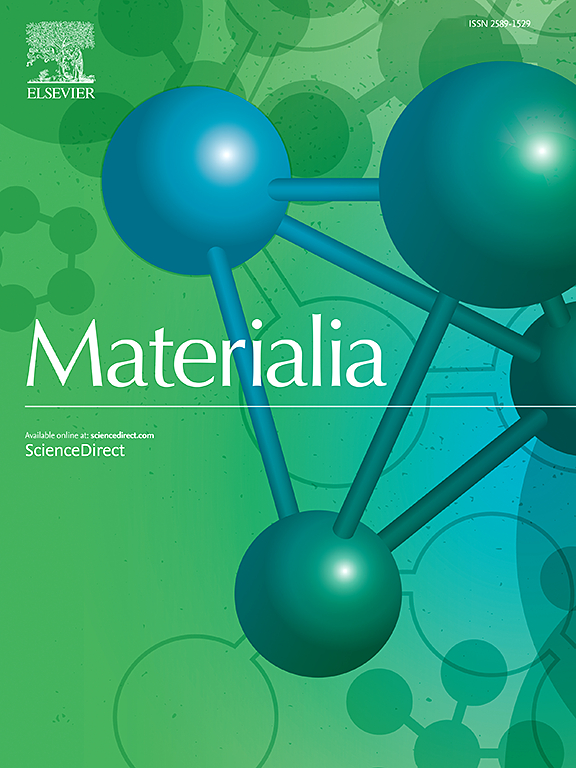Origin of enhancement of oxidation resistance of near β-Ti(Al) with addition of Ta: a combinatorial experimental and DFT analysis
IF 3
Q2 MATERIALS SCIENCE, MULTIDISCIPLINARY
引用次数: 0
Abstract
The study examines the effect of alloying tantalum (Ta) with the β-Ti(Al) solid solution on oxidation resistance at the temperatures of 1000 – 1200°C in air. Addition of 7 at.% Ta to β-Ti(Al) enhanced oxidation resistance by 97%. The oxide growth followed a linear growth mechanism in the initial stage, transitioning to a parabolic growth mode as time progressed. Transition from linear to parabolic growth occurred earlier as Ta content increased in the β-Ti(Al) phase. Both Ta-free and Ta-containing β-Ti(Al) formed an external oxide zone (EOZ) consisting of Ta-free rutile (TiO2) and alumina (α-Al2O3). However, the Ta-containing β-Ti(Al) also developed an additional phase, β-Ta2O5, in the inward region of the EOZ along with the Ta-containing TiO2. Presence of inert yttria markers at the oxide/air interface for the Ta-free β-Ti(Al) indicated that oxygen was the primary diffusing component contributing to the oxide growth. In contrast, markers inside the EOZ in the case of Ta-containing β-Ti(Al) suggested that both oxygen and metallic ions were involved in the oxide formation. Microstructural analysis by EBSD revealed columnar and equiaxed grains of TiO2 growing on either side of the β-Ta2O5 grains in EOZ, further supporting the involvement of both oxygen and metallic ions in oxide growth. The enhanced oxidation resistance of Ta-containing β-Ti(Al) was attributed to a change in the defect concentration of TiO2 as analysed via density functional theory (DFT). A Ti-Al-Ta-O phase diagram at 1200°C was established, and a comprehensive oxidation mechanism was proposed, integrating both experimental and computational insights.
加入Ta增强近β-Ti(Al)抗氧化性的原因:组合实验和DFT分析
研究了β-Ti(Al)固溶体与钽(Ta)合金在1000 ~ 1200℃空气中抗氧化性能的影响。7 at的加法。% Ta加入β-Ti(Al)后,抗氧化能力提高97%。氧化物的生长在初始阶段遵循线性生长机制,随着时间的推移过渡到抛物线生长模式。随着β-Ti(Al)相中Ta含量的增加,从线性生长到抛物线生长的转变发生得越早。不含ta和含ta的β-Ti(Al)均形成由不含ta的金红石(TiO2)和氧化铝(α-Al2O3)组成的外氧化区(EOZ)。然而,含ta的β-Ti(Al)也与含ta的TiO2一起在EOZ的内向区域形成了一个额外的相β-Ta2O5。在不含ta的β-Ti(Al)的氧化物/空气界面上存在惰性钇标记,表明氧是促进氧化物生长的主要扩散成分。相反,在含ta的β-Ti(Al)的情况下,EOZ内的标记表明氧和金属离子都参与了氧化物的形成。EBSD显微结构分析显示,在EOZ中β-Ta2O5晶粒两侧生长着柱状和等轴状TiO2晶粒,进一步支持了氧离子和金属离子参与氧化物生长。通过密度泛函理论(DFT)分析,含ta β-Ti(Al)的抗氧化性增强归因于TiO2缺陷浓度的变化。建立了1200℃时的Ti-Al-Ta-O相图,并结合实验和计算的见解,提出了一个全面的氧化机理。
本文章由计算机程序翻译,如有差异,请以英文原文为准。
求助全文
约1分钟内获得全文
求助全文
来源期刊

Materialia
MATERIALS SCIENCE, MULTIDISCIPLINARY-
CiteScore
6.40
自引率
2.90%
发文量
345
审稿时长
36 days
期刊介绍:
Materialia is a multidisciplinary journal of materials science and engineering that publishes original peer-reviewed research articles. Articles in Materialia advance the understanding of the relationship between processing, structure, property, and function of materials.
Materialia publishes full-length research articles, review articles, and letters (short communications). In addition to receiving direct submissions, Materialia also accepts transfers from Acta Materialia, Inc. partner journals. Materialia offers authors the choice to publish on an open access model (with author fee), or on a subscription model (with no author fee).
 求助内容:
求助内容: 应助结果提醒方式:
应助结果提醒方式:


